Discover the versatility of the Oster Bread Maker with its variety of recipes available in PDF manuals. Perfect for both beginners and experienced bakers, this appliance offers easy-to-follow guides to create delicious homemade bread. Whether you’re making classic white bread or experimenting with whole wheat and rye combinations, the Oster Bread Maker’s comprehensive recipe collection ensures perfect results every time, encouraging you to explore new flavors and techniques.
1.1 Overview of Oster Bread Maker
The Oster Bread Maker is a versatile kitchen appliance designed to simplify bread making at home. With models like the Oster 5834, 5836, 5838, and 5839, it offers features such as ExpressBake, delay timers, and customizable settings. These machines allow users to create a variety of bread types, from classic white to whole wheat and specialty loaves. The Oster Bread Maker’s ease of use and advanced settings make it ideal for both beginners and experienced bakers. Its compatibility with different ingredients ensures consistent results, making it a valuable addition to any home bakery.
1.2 Importance of Using Bread Flour
Using bread flour is essential for achieving the best results with your Oster Bread Maker. Bread flour, unlike all-purpose or cake flour, contains a higher protein content, which ensures a stronger gluten structure, leading to a lighter and airier loaf. This is particularly important for yeast-based bread recipes, as gluten development is crucial for rise and texture. Using the correct type of flour enhances the machine’s performance and guarantees a professional-quality finish. Substituting with other flours may result in dense or flat bread, making bread flour indispensable for optimal baking outcomes.
1.3 Benefits of Oster Bread Maker Recipes
Oster Bread Maker recipes offer unparalleled convenience and consistency, ensuring perfectly baked bread every time. With a wide variety of recipes available in PDF formats, users can explore everything from classic white bread to specialty loaves. These recipes are designed to maximize the machine’s features, providing clear instructions for ingredients and settings. The ability to customize recipes for different loaf sizes and ingredients adds flexibility, catering to various dietary needs and preferences. Additionally, the comprehensive guides included in these PDFs help users troubleshoot common issues, ensuring a flawless baking experience. This makes Oster Bread Maker recipes a valuable resource for both novices and experienced bakers alike.
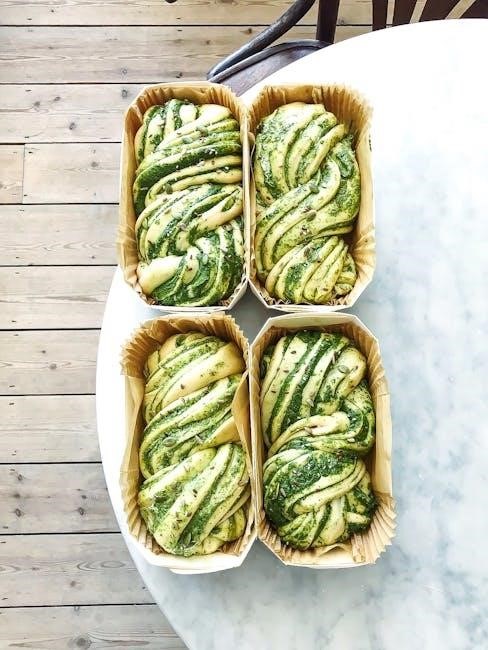
Understanding Your Oster Bread Maker
The Oster Bread Maker is designed for simplicity and efficiency, featuring customizable settings and a user-friendly interface. Its advanced features, such as delay timers and specific flour recommendations, ensure optimal performance. By following the provided PDF manuals, users can easily navigate the machine’s functions and settings, making it a versatile tool for creating a wide range of bread recipes with precision and ease.
2.1 Key Features of Oster Bread Makers
Oster Bread Makers are equipped with advanced features designed for convenience and precision. These include a 2-lb loaf capacity, EXPRESSBAKE technology for faster baking, and a delay timer for scheduled baking. Customizable crust color options and a non-stick bread pan ensure easy cleanup and perfectly baked loaves. The LCD display and intuitive controls make it easy to navigate settings and monitor progress. Additionally, the machine supports various dough and bread settings, allowing users to experiment with different recipes and ingredients. These features, combined with the provided PDF manuals, make the Oster Bread Maker a versatile and user-friendly appliance for home bakers.
2.2 Basic Settings and Customization Options
Oster Bread Makers offer a range of basic settings and customization options to suit various bread-making needs. Users can choose from settings like Basic, Whole Wheat, Rye, and EXPRESSBAKE for faster results. The machines also feature customizable crust color options, allowing bakers to select light, medium, or dark crusts. A delay timer enables scheduled baking, while programmable settings let users adjust cycle times and temperatures. These features, detailed in the PDF manuals, provide flexibility for creating personalized loaves, ensuring each batch meets specific preferences and dietary requirements. This adaptability makes the Oster Bread Maker ideal for both traditional and experimental recipes.
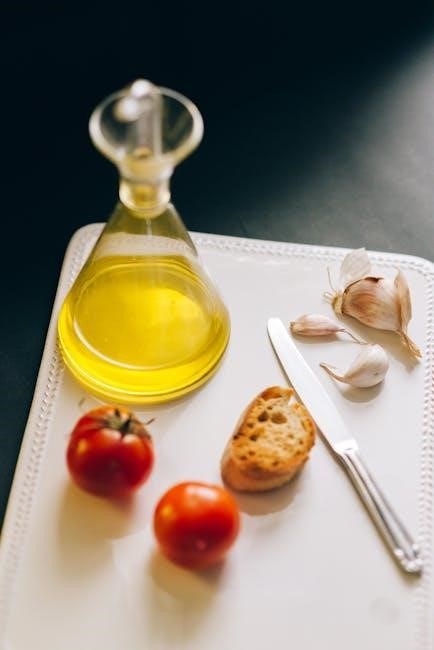
Essential Ingredients for Oster Bread Recipes
Bread flour is crucial for optimal results, as it provides the necessary gluten for a light, airy texture. Active dry yeast ensures proper rise, while liquids like water or milk hydrate the dough. Salt enhances flavor, and sugar or brown sugar feeds the yeast, promoting fermentation. Additional ingredients such as butter, oil, or herbs can be added for flavor customization. Always follow the ingredient ratios specified in the Oster Bread Maker PDF recipes for best outcomes.
3.1 Types of Flour for Bread Making
Bread flour is the most recommended for Oster Bread Maker recipes due to its high gluten content, which ensures a light and airy texture. Whole wheat flour offers a nuttier flavor and more nutrients, while rye flour adds a distinctive taste. All-purpose flour is not ideal as it lacks the necessary gluten for a perfect rise. For EXPRESSBAKE settings, bread machine flour is specifically designed to perform best. Combining different flours, like whole wheat and bread flour, can create a balanced loaf with enhanced texture and flavor. Always choose the right flour type based on your recipe for optimal results.
3.2 Role of Liquids in Bread Recipes
Liquids play a crucial role in bread making, as they hydrate the dough, ensuring proper texture and rise. Water, milk, or other liquids are essential for activating yeast and creating elasticity in the dough. When using an Oster Bread Maker, it’s important to add liquids first, followed by dry ingredients and yeast last. The ratio of liquids to flour must be precise to avoid a too-wet or too-dry consistency. Adjustments may be needed for high altitude or humidity. Proper liquid measurement ensures the dough mixes evenly, leading to a light and airy loaf. Always follow the recipe guidelines for best results.
3.3 Importance of Yeast in Bread Making
Yeast is the backbone of bread making, responsible for fermentation, which creates the light, airy texture of bread. Active dry yeast, rapid rise yeast, or bread machine yeast can be used in Oster Bread Maker recipes. Yeast must be added last to prevent premature activation and ensure proper fermentation. The right temperature and liquid conditions are crucial for yeast activity. Over- or under-proofing can ruin the loaf, so following recipe guidelines is essential. Yeast’s role in bread making is vital, making it a key ingredient for achieving the perfect rise and flavor in every batch baked in your Oster Bread Maker.
3.4 Other Key Ingredients and Their Functions
Beyond flour and yeast, other ingredients play crucial roles in bread making. Salt enhances flavor, strengthens gluten, and controls yeast activity. Sugars or sweeteners feed yeast, promoting fermentation and browning. Liquids, such as water or milk, hydrate ingredients and create dough consistency. Fats like butter or oil add tenderness and richness. Optional additions like herbs, garlic, or cheese provide unique flavors. Each ingredient’s function ensures a balanced, delicious loaf. Proper measurement and order of addition are vital, as outlined in Oster Bread Maker recipes, to achieve optimal results and customize your bread to perfection.
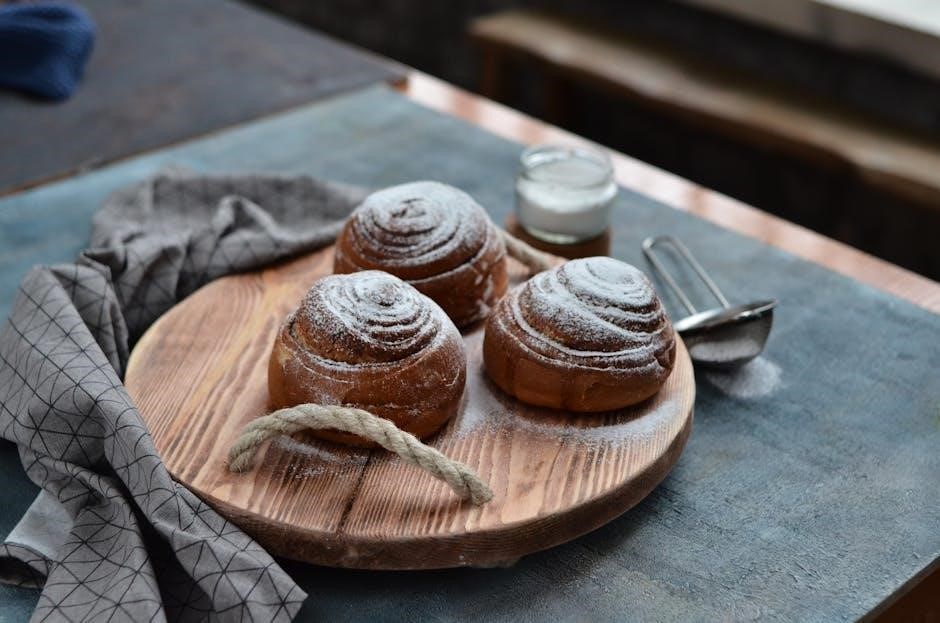
Basic Oster Bread Maker Recipes
Start with simple recipes like classic white bread or whole wheat, using essential ingredients and basic settings. Follow the manual’s step-by-step guide for perfect results.
4.1 Classic White Bread Recipe
Start with the classic white bread recipe, a timeless favorite. Combine 1 3/8 cups of water, 2 tablespoons of vegetable oil, 2 tablespoons of brown sugar, and 1 1/2 teaspoons of salt. Add 3 cups of bread flour and 2 teaspoons of active dry yeast. Place all ingredients in the bread pan, select the basic setting, and press Start. The machine will handle mixing, kneading, and baking. Perfect for beginners, this recipe yields a soft, delicious loaf. Follow the manual’s guidelines for precise measurements and settings to ensure a flawless result every time.
4.2 Simple Whole Wheat Bread Recipe
Create a nutritious and flavorful loaf with the simple whole wheat bread recipe. Combine 1 5/8 cups of water, 2 teaspoons of salt, 4 2/3 cups of whole wheat flour, and 3 teaspoons of active dry yeast. Optionally, add 1/3 cup of packed brown sugar for sweetness. Place liquids first, followed by dry ingredients and yeast last. Select the basic setting on your Oster Bread Maker and press Start. This recipe yields a hearty, wholesome bread perfect for sandwiches or toast. For a lighter texture, mix whole wheat flour with white bread flour. Follow the manual’s guidelines for best results.
4.3 Basic Bread Making Process
The basic bread making process with an Oster Bread Maker is straightforward. Start by adding ingredients to the bread pan in the recommended order: liquids first, followed by dry ingredients, with yeast last. Close the lid, select the basic setting, and press Start. The machine will mix, knead, rise, and bake the dough; After 5-6 minutes, scrape the pan sides if needed. Let the machine complete the cycle. Once done, remove the loaf and let it cool. This process ensures a perfectly baked loaf every time. Always follow the manual’s guidelines for ingredient measurements and settings.

Advanced Oster Bread Maker Recipes
Explore advanced recipes like specialty breads (garlic, herb, or cheese) and custom combinations. Adjust recipes for different loaf sizes and experiment with unique flavors for variety.
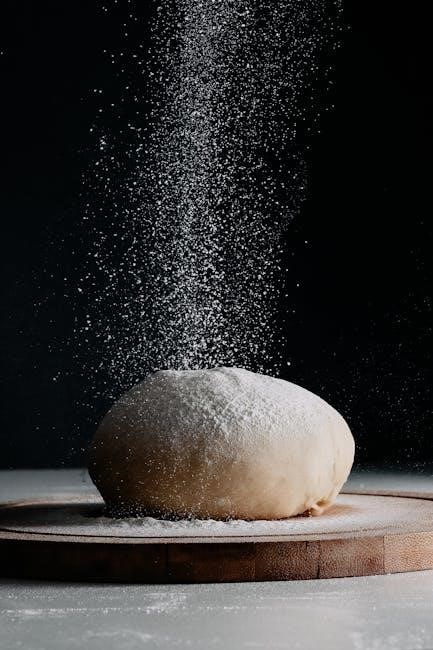
5.1 Whole Wheat and Rye Bread Combination
A delightful blend of whole wheat and rye flours creates a robust and nutritious bread. Combine 2 cups of whole wheat flour with 1 cup of rye flour for a lighter loaf. Add 1 ½ tsp of salt, 3 tbsp of sugar, and 2 cups of water. Use 2 tsp of active dry yeast for proper rise. Follow the basic bread-making process, ensuring liquids are added first, followed by dry ingredients, with yeast last. This combination offers a balanced flavor and better texture. Adjust settings according to your Oster Bread Maker manual for optimal results. Experiment with additional spices or seeds for extra flavor.
5.2 Specialty Breads (e.g., Garlic, Herb, or Cheese Bread)
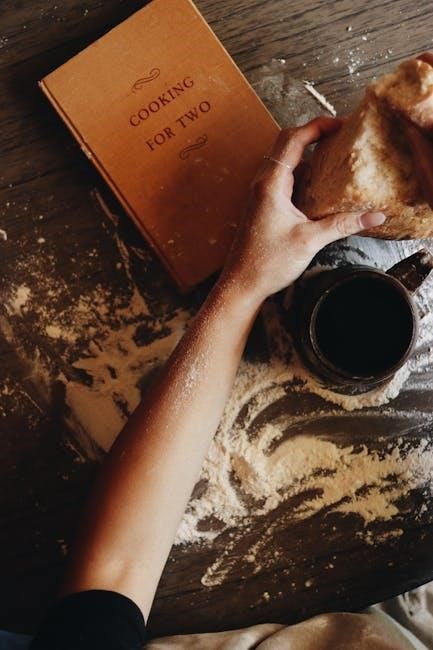
Elevate your bread-making skills with specialty bread recipes. For garlic bread, mix 1 tbsp of minced garlic into the dough before baking. Herb bread can be infused with 1 tsp of dried herbs like rosemary or thyme. For cheese bread, add ½ cup of shredded cheddar or Parmesan during the final mixing phase. Ensure to use bread flour for the best texture and active dry yeast for proper rise. Follow the basic bread-making process, adjusting settings as per your Oster Bread Maker manual. These specialty breads offer unique flavors and aromas, perfect for sandwiches, snacks, or accompaniments to meals.
5.3 Customizing Recipes for Different Loaf Sizes
Customize your Oster Bread Maker recipes to suit different loaf sizes by adjusting ingredient quantities. For a 2-pound loaf, use 3 cups of bread flour, while a 1.5-pound loaf requires 2 cups. Maintain the same ingredient ratios and yeast proportions. Liquids should be scaled accordingly to ensure proper dough consistency. Use the delay timer for convenience and adjust the crust color setting as desired. Always refer to your Oster Bread Maker manual for specific guidance on scaling recipes. Experiment with sizes to find your perfect loaf, ensuring each batch meets your expectations for texture and flavor.

Troubleshooting and Tips
Common issues include incorrect flour types or yeast, affecting rise. Ensure proper pan placement and scaling recipes for loaf size. Adjust salt or liquids for crust color, and refer to manuals for high-altitude adjustments. Always measure ingredients accurately and use the delay timer wisely for fresh results. Regular machine maintenance ensures longevity and consistent performance. Troubleshoot by checking yeast expiration and ingredient ratios for optimal bread-making success every time.
6.1 Common Mistakes to Avoid
Common mistakes when using an Oster Bread Maker include using incorrect flour types, such as all-purpose instead of bread flour, which can lead to poor rise. Overmixing or undermixing ingredients can also affect texture. Forgetting to add yeast or using expired yeast is another frequent error. Incorrect liquid measurements or improper placement of yeast in the pan can disrupt fermentation. Additionally, not adjusting recipes for high altitudes or failing to follow the recommended order of ingredients can result in subpar loaves. Avoiding these pitfalls ensures better bread quality and consistent results.
6.2 Adjusting Recipes for High Altitude
At high altitudes, bread recipes may require adjustments due to lower air pressure and humidity. Reduce yeast by 1/4 to 1/2 teaspoon to prevent over-rising. Decrease sugar slightly to slow fermentation. Increase liquid by 1-2 tablespoons to compensate for dryness. Check dough consistency during mixing and adjust as needed. Lower oven temperature by 1-2% to control rise. Monitor baking time closely, as bread may cook faster. For optimal results, use high-altitude flour if available. These tweaks ensure a lighter, evenly baked loaf even in high-altitude conditions. Always refer to your Oster Bread Maker manual for specific altitude adjustment guidelines.
6.3 Maintaining Your Oster Bread Maker
Regular maintenance ensures your Oster Bread Maker performs optimally. After each use, clean the bread pan and exterior with a damp cloth, avoiding abrasive cleaners. Remove any dough residue and wash the kneading paddle. Dry all parts thoroughly to prevent rust. For tougher stains, mix baking soda and water to create a paste, apply it, and let it sit before wiping clean. Refer to your user manual for specific care instructions to extend the lifespan of your machine and maintain its efficiency in producing perfect loaves.
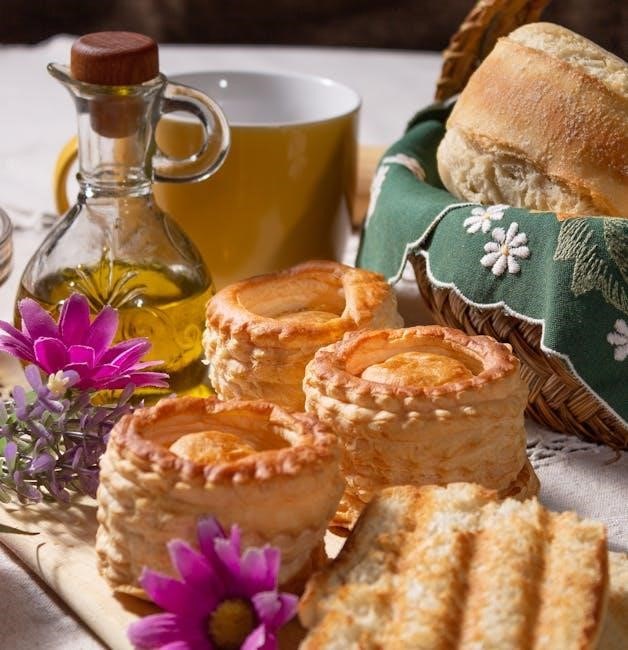
Accessing Oster Bread Maker Manuals and Recipes
Access Oster Bread Maker manuals and recipes easily via official PDF downloads. Visit the Oster website or model-specific pages like 5834 or 5839 for comprehensive guides.
7.1 Finding the Oster Bread Maker Manual PDF
To find the Oster Bread Maker manual PDF, visit the official Oster website or search for model-specific downloads like the 5834 or 5839. Use keywords like “Oster Bread Maker manual PDF” or “Oster 5834 bread recipes PDF” for quick results. Many manuals are available free of charge and include detailed instructions, troubleshooting tips, and recipes. Ensure you download from trusted sources to avoid unauthorized content. The PDFs typically cover operation, settings, and care, making them indispensable for optimal use of your bread maker.
7.2 Navigating the Oster Bread Maker Recipe Book
The Oster Bread Maker Recipe Book is designed to guide users through various bread-making options. It typically starts with classic white bread recipes, followed by whole wheat and specialty variations like garlic or herb bread. Each recipe includes precise measurements, step-by-step instructions, and tips for customization. Users can easily navigate through categories, such as basic, whole grain, and dough settings. The book also offers troubleshooting advice and altitude adjustments, ensuring success regardless of skill level or location. Its clear organization makes it simple to explore new recipes and perfect your bread-making skills with ease.
7.3 Online Resources for Oster Bread Maker Recipes
Online resources provide extensive support for Oster Bread Maker users, offering downloadable PDF manuals and recipe books. Websites like the official Oster site and third-party platforms feature detailed guides, including recipes for classic bread, whole wheat, and specialty options. Users can access model-specific manuals, such as the Oster 5834 PDF, which includes step-by-step instructions and troubleshooting tips. Additionally, online forums and baking communities share user-generated recipes and advice, making it easy to explore new ideas and refine your bread-making skills with the Oster Bread Maker.
Mastering Oster Bread Maker recipes ensures delicious homemade bread. Explore various flavors and techniques, and enjoy the satisfaction of creating perfect loaves each time.
8.1 Final Tips for Perfect Bread Making
For perfect bread making, always use bread flour and measure ingredients accurately. Let the machine handle mixing and rising—avoid overcomplicating recipes. Ensure yeast is fresh and properly activated. Adjust recipes for high altitude if necessary. Clean your Oster Bread Maker regularly for optimal performance. Experiment with flavors but follow basic guidelines. Store bread properly to maintain freshness. Refer to the manual for troubleshooting and customization tips. With practice, you’ll master the art of bread making and enjoy homemade loaves tailored to your taste preferences.

8.2 Encouragement to Experiment with New Recipes
Don’t be afraid to explore beyond basic recipes! The Oster Bread Maker is a versatile tool for creativity. Try blending different flours, like whole wheat and rye, for unique textures. Add herbs, garlic, or cheese for flavorful twists. Experimenting with liquids, such as milk or yogurt, can enhance moisture and taste. Remember, every batch is a learning opportunity. Use the manual’s tips to guide your creativity and adjust settings for custom results. Share your creations with family and friends, and enjoy the satisfaction of crafting personalized bread. Happy baking!




Leave a Reply
You must be logged in to post a comment.